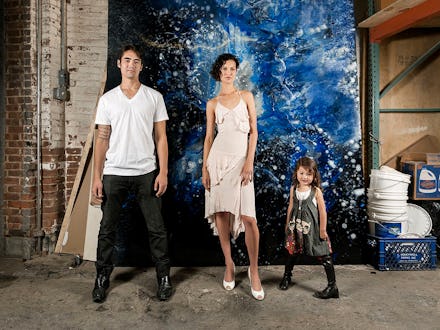Fantastic Photos Will Challenge the Way You Think About the Typical American Family

National Geographic recently proclaimed that the face of the average American is just now becoming more multiracial. But one photographer's exhibition demonstrates the argument by the magazine's detractors: It's actually been that way for quite some time.
Korean-American artist CYJO's newest project, "Mixed Blood," shows that the stories of multiracial people have been long overlooked within an intensely negative racial climate, which often frames things in black and white.
The exhibition features multiethnic families from New York City and Beijing, illustrating that many Americans represent multiple ethnic backgrounds, various world cultures and histories linked to migration movements.
Each portrait, along with its corresponding interviews, seeks to unearth a complicated history of multiracial people that's been deliberately ignored and erased, both in government institutions and in everyday life. American laws such as Racial Integrity Act of 1924 pushed people of color and their multiethnic counterparts further into the margins, denying a swathe of civil rights if an individual had any black ancestry, otherwise known as the "one drop rule." These attitudes persisted throughout the 20th century and, in the process, denied the multiracial Americans the recognition and rights they deserve.
Through the exhibition, CYJO shows that multiracial people have long been a part of America's social fabric, despite what recent events would otherwise suggest.
It wasn't until the 2000 U.S. Census that, for the first time, multiracial Americans had the option to identify as such, as racial categories expanded beyond the narrow categories previously drawn. Based on National Geographic's analysis, 6.8 million people checked off more than one race. And, during the 2010 U.S. Census, that number jumped by 32 percent, making "multiracial" one of the fastest growing racial groups in the U.S.
The exhibition not only amplifies the visibility of multiracial people, it also highlights the loving bonds at the foundation of these families.
“I feel a strong connection to the portraits and narratives in CYJO's 'Mixed Blood.' They are at once familiar and provocative," said educator Maya Soetoro-Ng, President Barack Obama's half-sister. "They highlight the borrowing, plucking, reshaping, and discarding that we do in fixing our identities at any given time, in a particular space, and for a particular purpose."
The photo series also applies to the racial climate in China, amid the country's increasingly rapid urbanization. China's attitudes on multiracial families have come a long way, but the complications of identity erasure remain. Sponsored by the U.S. Embassy in Beijing, "Mixed Blood" is first set to travel around China, where the project will allow some of the featured Chinese citizens to bring more awareness to some of the country's 56 recognized ethnic groups and the difficulties surrounding interracial marriages.
"I noticed in China that being married to people with different ethnic backgrounds from other continents was more unusual than usual especially to those with conservative mindsets," CYJO, who splits her time between New York and Beijing, told Mic.
In fact, race itself is a social construction, rather than something a person is biologically given at birth. Racial categories, or "natural varieties," were actually devised in the late 18th century by German scientist Johann Friedrich Blumenbach. But somehow, despite how polarizing and destructive racial categories have become in society today, there's a gradual shift toward widespread acceptance of difference. However, the victory over these artificial racial divides often is celebrated prematurely, as what happens when people gush about living in a "post-racial" society.
It's a conversation and, ultimately, a key lesson that translates across cultures and national contexts. CYJO said that became even more clear based on some of her subjects' interviews.
"'Mixed Blood' can have multiple meanings and meaning changes depending on cultural generation and social context. For example, with the James family — Matthew's father, with Irish and German blood, was definitely considered mixed race during his grandfather's time. He isn't considered mixed by many today," she said.
Ultimately, CYJO hopes people walk away from her exhibit with a refreshed view of what it means to have more than one racial or ethnic identity.
"If you think about it, people have been mixing for as early as people have been migrating from one place to another and forming families. But this definition of being mixed seems to be defined differently in different social contexts," she said.
And these profiled families all disrupt the way race orders our lives and interactions — proving yet again that we can't judge a book by its cover.
Mixed Blood is a traveling exhibition in China that launched at Today Art Museum in Beijing and is sponsored by the US Embassy in Beijing, China. It us curated by Nik Apostolides and designed by Timothy Archambault.
Images Credit (all): CYJO
Updated: July 15, 2014, 5:57 p.m. — An earlier version contained language that has been clarified by the artist.